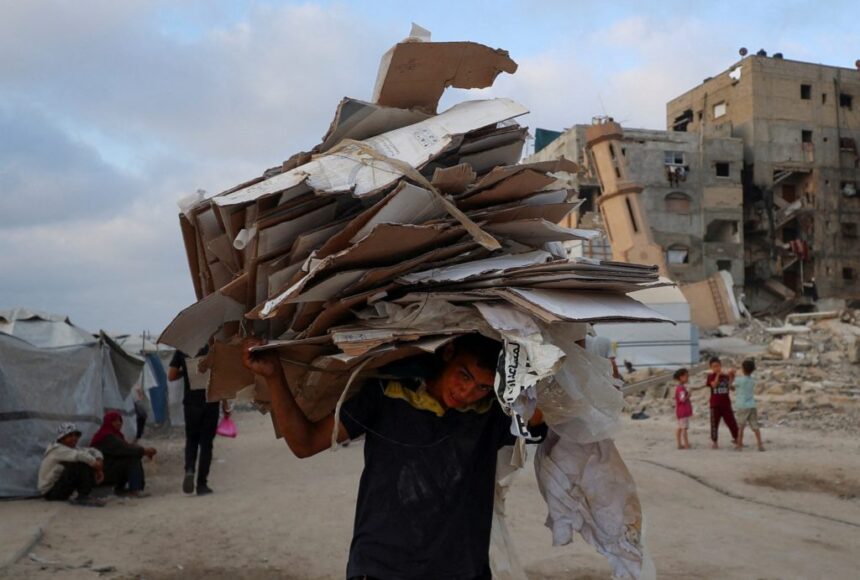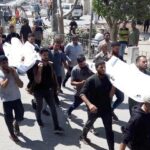Last Thursday’s tragedy at the Nabulsi Junction in northern Gaza marked another devastating chapter in this war. At least 112 Palestinians lost their lives while desperately seeking humanitarian aid—shot, crushed, or trampled in the chaos that ensued when Israeli forces opened fire on crowds surrounding aid trucks.
I’ve reported from conflict zones for nearly two decades, but the images emerging from this incident reveal a humanitarian catastrophe that continues to worsen by the day. According to the Hamas-run Gaza Health Ministry, over 30,000 Palestinians have now been killed since October, with the majority being civilians. The UN reports that roughly 85% of Gaza’s 2.3 million residents are displaced, most multiple times.
“We were just trying to get flour for our children,” said Ahmed, a 43-year-old father I spoke with via secure messaging. He described how thousands had gathered along Rashid Street after hearing rumors of an incoming aid convoy. “The shooting started without warning. People were falling everywhere. Some were hit by bullets, others crushed under the trucks as they tried to escape.”
The Israeli military initially claimed their forces fired warning shots after feeling threatened by the approaching crowd, but later acknowledged the situation had “deteriorated into a tragic event.” President Biden expressed being “outraged and heartbroken,” while Secretary of State Antony Blinken called the deaths “totally unacceptable” during his visit to Egypt this week.
Walking through Gaza City last month, before access became nearly impossible, I witnessed firsthand how food insecurity has become weaponized. The World Food Programme now estimates 577,000 Gazans face catastrophic hunger, with aid workers describing conditions approaching famine in northern areas. International agencies struggle to distribute what little aid enters through heavily restricted border crossings.
“We’re facing unprecedented obstacles to humanitarian access,” explained Juliette Touma from UNRWA during our conversation in Jerusalem. “Aid trucks face hours of inspection, routes are restricted, and our staff face constant danger. This isn’t just about logistics—it’s about political will to allow meaningful humanitarian access.”
The White House announced plans to establish a temporary pier for maritime aid deliveries, acknowledging the land routes aren’t sufficient. Yet multiple aid experts I consulted questioned whether this approach addresses the fundamental problem: Israel’s control over who and what enters Gaza.
For civilians caught in this nightmare, the daily struggle for survival grows more desperate. Hospitals function without basic supplies. Clean water is scarce. Most buildings in northern Gaza stand damaged or destroyed. The banking system has collapsed, leaving families without access to savings.
In Jabaliya refugee camp, where Israeli forces conducted another major operation last week, residents described surviving on one meal daily, often just bread and tea. Children show visible signs of malnutrition—distended bellies, thinning hair, and constant lethargy, according to doctors at Al-Awda Hospital working under nearly impossible conditions.
“We’re treating diseases we haven’t seen in decades,” Dr. Khalil Nasser told me. “Hepatitis A from contaminated water. Malnutrition-related conditions. Even polio is now a concern with vaccination programs halted.”
The humanitarian crisis extends beyond physical hunger. Mental health professionals warn of generational trauma being inflicted. In makeshift shelters housing thousands, privacy doesn’t exist. Children witness death regularly. Basic sanitation has collapsed in many areas.
Meanwhile, international mediation efforts continue with little progress. Hamas still holds Israeli hostages taken during their October 7 attack that killed approximately 1,200 Israelis. Prime Minister Netanyahu faces pressure from hostage families while simultaneously managing hardline coalition partners who oppose any concessions.
As negotiations stall, aid organizations warn that time is running out for Gaza’s population. The UN’s emergency relief coordinator Martin Griffiths described the situation as “apocalyptic” during last week’s Security Council briefing.
For Palestinians like Samira, a 34-year-old teacher now sheltering in Deir al-Balah with her three children, each day brings impossible choices. “Do I use our water to cook what little food we have, or save it for drinking? Do I risk going out to find food when there might be airstrikes, or watch my children go hungry another day?”
These aren’t abstract policy questions but life-or-death decisions faced hourly by civilians caught in what’s becoming one of this century’s worst humanitarian disasters. As the international community debates, civilians continue dying—not just from bombs and bullets, but increasingly from hunger, disease, and the collapse of basic services.
The Thursday massacre at the aid distribution point represents the terrible intersection of military operations and humanitarian crisis. For Gaza’s civilians, aid convoys shouldn’t become death traps. But in a war zone where safe spaces have disappeared, even the desperate search for flour can prove fatal.






